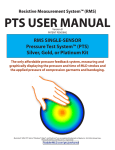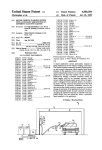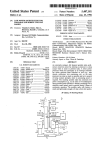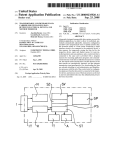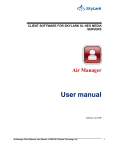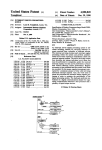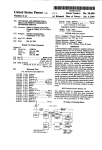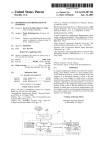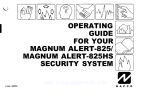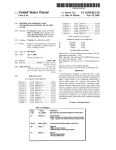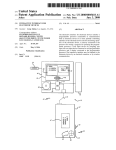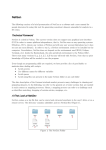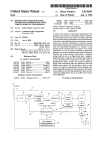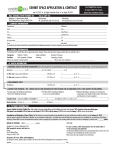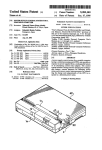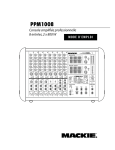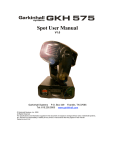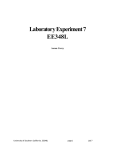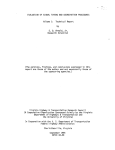Download llllllllllllllllllllllllllllilllllllllllllllllllllllIllllllllllllllllllllll
Transcript
llllllllllllllllllllllllllllilllllllllllllllllllllllIllllllllllllllllllllll . US005305467A Unlted States Patent [19] [11] Patent Number: Herndon et al. [45] [54] [75] Apr. 19, 1994 LOCAL AREA NETWORK FOR FLEXIBLE 4,684,941 8/l987 Smith ........................... .. 340/825.52 DIGITAL COMMUNICATIONS WITHIN 4,686,671 8/1987 Burian et a]. 4,726,050 2/1988 Menich ............................... .. 455/33 4,918,746 8/ 1990 Serizawa .......................... .. 455/561 AND BETWEEN RF BASE STATIONS Inventors: Charles C. Herndon, Forest; John R. Martin, Lynchburg; Rodney L. Lynchburg; Daniel I. . 8“ ’ ’ 4,993,059 2/1991 Smith .................. .. 455/33 ' 5,081,641 [73] Assignee: ?rzcsslosnglliblzliptgiblgeaCommumcanons -’ y . .. 1/1992 Kotzin et al. ..... .. 455/331 FOREIGN PATENT DOCUMENTS ' Appl No _ 620 423 . ..... ._ 455/341 4,730,187 3/1988 Menich et al. . 4,789,983 12/1988 Acampora et al. ................. .. 370/84 4,866,710 9/1989 Schaeffer ............................ .. 455/33 DiSSOSWay Ct a1. . zcihwifl?’ l?gfej‘t‘bggé?‘fame I" [2]] Date of Patent: 5,305,467 3638735 5/ 1988 Fed. Rep. of Germany ...... .. 455/89 , _ Primary Examiner-Reinhard J. Eisenzopf [22] [51] Flled' Dec' 3’ 1990 Int. Cl.5 ............................................ .. H04B 3/00 Assistant Examiner—-Chi Pham Attorney, Agent, or Firm-Nixon & Vanderhye [52] US. Cl. ................................ .. 455/561; 455/671; [58] Field of Search .................... .. 455/73, 75, 89, 5,1, 455/56.l, 34-1, 331, 54-1, 53-1, 67-1, 49-1, 38-1; A LAN multi-node generic digital signal communica tions link within a radio frequency (RF) base station 370/95.1, 85.1, 35-2, 35-3; 379/ 58; 375/ 36; 340/825-52 system communicates control signals within and be tween base stations. The generic digital signal link elim 370/85.1; 379/58 [56] [57] ‘ ABSTRACT References Cited rates thehuse of multiple lines for .respectiye futnctioins y us1ng ‘t e same generic commumcations inter ace or us‘ PATENT DOCUMENTS various different functions. By using such a generic 4,584,678 4/1986 Ozeki et al. ...................... .. 370/85.3 4,587,651 5/1986 Nelson et a1. .................. .. 370/85.l3 signal for inter and intra base Station commu nic?tions’ RF and auxiliary comm] become Standap ags/$1“? 31' ' dized-reducing complexity in the product, in the doc 455/89 4:608:70O 8/1986 Kirtley, Jr. et al. ............. .. 370/85.2 4,636,791 l/l987 4,667,191 5/ 1987 Comroe et a! ...................... .. 455/73 umemam" and 1“ ?eld re1m" techmques Burke et ai. . 10 Claims, 7 Drawing Sheets ' _____________________ "I =l WY 1 . 24 i Y 1 RF I ' RCVR | seuoms TRANSCEIV ER /22 RCVD : INTERFACE 36 213 (P:_ 12\ l I"2 DISPATCH 1 TL 1 TL I 12“ 12B : I ~m" : 19 crcss c'nzss 3mm FILTER : (32 : l I“ : : FILTER so $55M n N on 112" ‘I DlglTAL 5' ML PROCESSING \34 | 1 . REPEATER BASE STATION Y RECEIVIMEVER 5.2%}; "G I ___ CONTROL| l L I1 >-- east : B l ' : $856014 A | ‘‘ 10/ CONSOLE i $151014 I 1 53 ) \wmo * 1 XMITTER ‘T’ MODULE 8 : mLER \irgo : 5 RF 1 /50 20c~ 2504’ "1288 \ZZa : m |"'"". 52'1"???“ i | “1 COMBINER 20\ LAN “'11s. .5” ' x i 51 ' ' : 1 I I l J i S 14b 10 US. Patent Apr. 19,1994 FROM FIG. 2a Sheet 4 of 7 ‘ is 5,305,467 2 C GSC ALE---—> 892255100». DSP ADDR ADQ -7 009-7 LATCHED l/O PPI AG I CS ‘m RF TO LINE SEL. TX SEL. __1 I I TO MODEM 48 OR | I HANDSET 52 US. Patent ( Apr. 19, 1994 Sheet 7 of 7 START ) 5,305,467 START 410 4QO\ INITIALIZE GSC M33 N ? Y GET NEW 4°2'\ FREQUENCY RCV \412 MESSAGE 414 oouvsn'r TO 404\ PRESCALER ~ 4,6 FORMAT ( Y PROCESS MESSAGE SELECT 406 \ BUILD MSG m BUFFER TX SYNTH \41a TRANSMIT DATA 4°8\ SEND M36 OVER LAN DONE CONTROLLER Fig. 5A 28 TO PI>"‘ESCALERF\"'2o 3°4 INTERFACE Moouua 5,305,467 1 2 section may monitor received signal strength and/or LOCAL AREA NETWORK FOR FLEXIBLE DIGITAL COMMUNICATIONS WITHIN AND BETWEEN RF BASE STATIONS carrier detect, DC input current to the transmitter ?nal ampli?er, etc.). CROSS-REFERENCES TO RELATED _ APPLICATIONS ' In the past, such control and status signals have been communicated between the control section and the RF section over an array of dedicated parallel conductors. One typical con?guration used in the past was to pro vide the RF section and the control section each with a multipin connector. A multiconductor cable (or, in ' This application is related to the following common ly-assigned copending patent applications (all of the disclosures of which are hereby incorporated by refer some cases, a bus backplane) was used to convey, in ence herein): US. application Ser. No. 07/596,357 now abandoned parallel, all of the various signals that needed to be communicated between the RF section and the control of Vignali et al ?led Oct. 12, 1990 entitled “A Full section. For example, one or more conductors might be Duplex RF Repeater/Base Station Providing Mi croprocessor-controlled Simultaneous CTCSS Tone Encode/Decode”; dedicated to carrying a signal generated by the control section for controlling whether or not the transmitter in the RF section is keyed; one or more further conductors US application Ser. No. 07/620,422 now abandoned might be dedicated to carrying frequency programming of Herndon et al ?led concurrently herewith enti control signals from the control section to the receiver tled “Remote Control of RF Base Station Via Digi frequency synthesizer in the RF section, one or more 20 tal Communications”; and still further conductors might be dedicated to carrying US. application Ser. No. 07/620,421 of Nickel 'al a1 control signals from the control section for program ?led concurrently herewith entitled “Digital Sig ming the transmitter frequency synthesizer, etc.). Although such dedicated parallel conductor-type nal Processor for Radio Base Station”. interconnection arrangements work, they have certain FIELD OF THE INVENTION 25 disadvantages. One disadvantage of such prior art inter The present invention relates to radio frequency (RF) connection arrangements is the relatively high cost. repeating type transceivers of the type which transmit Multipin connectors and associated cables are expen and receive radio frequency signals, and more particu larly to so-called Base Station RF transceivers. Still sive. Moreover, since radio frequency signals and digi niques and arrangements for communicating digital precautions must be taken to minimize RF currents ?owing on each such conductor. Each such conductor had to be “RF decoupled” at both the RF section end and the control section end using RF shunting and/or tal control signals are not compatible with one another, more particularly, the present invention relates to tech 30 control signals within and between such RF base sta trons. BACKGROUND AND SUMMARY OF THE INVENTION 35 bypass networks (e.g., series-connected RF chokes and shunt-to-ground decoupling capacitors). Since each individual conductor had to include an RF decoupling Many modern radio frequency (RF) base stations network at each end, RF decoupling added signi?cantly have separate RF and control sections. A base station to the cost and complexity of the base station. RF section typically includes mostly analog circuitry (e.g., RF ampli?ers, RF oscillators, RF and IF receiver 40 In addition, such parallel dedicated conductor inter connections created reliability and service problems. ampli?ers/?lters, etc.) Most modern RF base stations Reliability problems are created whenever an additional available today control such an RF section with a digi mechanical-type electrical connection is introduced. tal (e.g., microprocessor based) control section. Such a Such connections can corrode or otherwise mechani digital control section can provide expanded control capabilities and ?exibility, thereby providing many 45 cally deteriorate, degrading or destroying critical inter advantages over prior analog control circuit arrange connections between the RF section and the control ments. section. Preventive maintenance efforts had to be ex pended to ensure such connections were properly main As is well known, digital circuits are not particularly tained. As the number of conductors increased, the compatible with RF signals. The RF section of a base station is therefore almost always housed in a separate 50 complexity of testing for and isolating base stations faults also increased (thus increasing down time and shielded enclosure to prevent RF signals radiated di rectly by the power ampli?er and other components therein from reaching the sensitive digital circuitry and vice versa (digital circuitry getting into receiver). service time). Still further complexity is introduced by the require ment that most RF base stations must supply their cus Interconnecting the RF section with the control sec 55 tomers with a wide variety of different base station options. The Federal Communications Commission tion is typically a relatively dif?cult and signi?cant authorizes base station operation on a user-by-user basis. problem. A relatively large number of signals must pass Such authorizations specify different operating frequen between the RF section and the control section. For example, the control section may typically program the operating frequencies of the transmitter and the re cies for different users, and may typically also specify different RF output powers for different users. One user may be authorized to operate with only, say, 100 watts of RF power, where as another user may be authorized ceiver within the RF section and may also directly control various other parameters of RF section opera to operate with several hundred watts of output power tion (e.g., whether or not the transmitter is'keyed, the state of an RF antenna relay, the transmitter ?nal ampli (different antenna configuration can also affect the ?er power output, etc.). In addition, the control section 65 power output required by a base station transmitter). must monitor various status and other parameters pro The user needing only relatively low output power vided by the RF section in order to ascertain the state of should not have to buy a base station having relatively operation of the RF section. For example, the control high RF output power capability, since the high-pow 3 5,305,467 4 ered components are generally more expensive and drastically increase the cost of the base station. Thus, for marketing and other reasons, base station manufac turers found it necessary to provide different RF output 802.3 LAN Standard 1.0 MBps). The Intel 80Cl52 was thus designed to make it possible to implement a LAN by merely more or less directly interconnecting 80Cl52 power options for their base stations. Similarly, differ ceiver ICs to transmit and receive the serial data). Digital signal serial links are not unknown in the world of RF systems. For example, it is generally known to interconnect a digital controller with RF microcontrollers together (using appropriate trans ent users may be assigned by the FCC to operate on completely different bands within the RF spectrum. RF circuitry designed for operation on a relatively low (e.g., several hundred megahertz) RF frequency is not capable of operating at high (e.g., 800 or 900 MH) RF components within a mobile radio transceiver using a frequencies. Accordingly, to meet the needs of a wide serial communications link. See, for example, US Pat. No. 4,903,262 issued 20 Feb. 1990 entitled "Hardware variety of users, a base station manufacturer must pro Interface and Protocol for A Mobile Radio Trans ceiver"; and copending divisional application thereof Ser. No. 07/449,790 filed 15 Dec. 1989 now US. Pat. and for different power output levels. Perhaps the most economic way for a base station 5 No. 5,109,543. See also US. Pat. No. 4,590,472 to Ben vide different base stations for different operating bands manufacturer to meet such a wide variety of customer needs is to make different RF sections for different RF son et al; US. Pat. No. 4,636,791 to Burke et al; and US Pat. No. 4,684,941 to Smith et al. In addition, commonly output powers, frequencies of operation, etc., and to make his control section mostly generic with respect to assigned U.S. patent application Ser. No. 07/532,164 all such different RF sections. Thus, each of the RF sections can be made to be "plug compatible" with the same control section. While such an arrangement is both possible and practical, it introduces further com “Fail-Soft Architecture for Public Trunking System” filed 5 Jun. 1990 now US. Pat. No. 5,175,866 entitled describes a trunked RF repeater arrangement wherein various "trunking cards" each controlling an RF trans ceiver are linked together and with a dispatch console via a common "backup serial link." Base stations are plexities. Providing such a generic parallel interconnec tion interface so that the control section may interface 25 now available that use multiple and dedicated relatively low-speed V0 for RF control, but such I/O arrange with any RF section usually requires the control inter ments are relatively in?exible and have no facilities for face to provide a set of conductors that is a superset of inter base station communications. conductors needed by any specific section. For exam The present invention solves many of the problems ple, unless very carefully designed so that all of the RF sections receive and provide the same control and status signals, some RF sections will not use some of the paral lel connections provided to it. In order to accommodate the many different system configurations that are possi ble, the amount of I/O became large and very difficult to maintain and understand. Moreover, such careful mentioned above by providing a generic digital control signal link for communicating digital control signals within and between RF base stations. This new arrange ment for communicating control signals within and between base stations practically reduces the number of separate interconnections between base station compo nents, standardizes the way such components communi cate with one another, allows single-point monitoring of design to provide generic parallel dedicated conductor interface is difficult and expensive and also may hamper further system expansion. Once the interface has been designed and manufactured, it is virtually impossible to add additional signal lines (e.g., to add further options an entire system (e.g., comprising one or many RF base stations), increases reliability, and reduces hardware 40 complexity and cost. or capabilities in response to customer demand) without The generic digital signal link provided by the pres significant redesign and remanufacturing efforts. Also, ent invention also eliminates the use of multiple lines for since the I/O lines were dedicated and implemented in respective functions by using the same lines for various hardware, implementation was costly and changes were different functions depending upon requirements. By 45 using such a generic digital signal link for inter and intra very difficult. base station communications, RF and auxiliary control Of course, much work has been done in the ?eld of digital signal communications. For example, local area networks (LANS) are used throughout the world to become standardized-reducing complexity in the product, in the documentation and in field repair tech niques. link computers together. In addition, serial digital com munications protocols and conventions have become 50 In the preferred embodiment in accordance with the present invention, the generic digital signal link is im relatively standardized. As one example, the pervasive plemented using a multipoint communication architec standardized RS-232C serial digital signal interface is ture (e.g., EIA RS485) with a Local Area Network (LAN) communications protocol. Many system compo other digital processor or to a peripheral. Moreover, some microprocessor manufacturers have 55 nents may be connected to the same link with no impact commonly used to connect a digital processor to an begun providing LAN software and associated hard on system hardware performance. This permits the same link used for control interface between compo nents (e.g., the control section and an RF section) within a base station to also be used for communicating nel (GSC) which is a multi-protocol high performance serial interface targeted for data rates up to two mega 60 with components and systems external to the base sta ware interfaces on-chip. As one example, the Intel 80C152 microprocessor includes a Global Serial Chan tion. The generic link provides virtually unlimited ex bits per second with on-chip clock recovery. The 80Cl52 implements the Data Link Layer and the Physi cal Link Layer as described in the ISO reference model for open systems interconnection. The GSC provided on Intel's 80C152 was optimized to implement the Car 65 rier Sense Multi-Access with Collision Detection required to adapt the system for a completely new sys' tem component) and thus provides an expandability never before available in RF base station architectures. (CSMA/CD) protocol, and was designed speci?cally to nal link is used for programming transmitter and re ceiver local oscillator synthesizers and is also used to allow standard baud rates (such as the proposed IEEE pansion capabilities e.g., (only software changes are In the preferred embodiment, the generic digital sig 5,305,467 5 transmit fault status signals from the RF section to the control section. This same link is additionally used to permit the control section to control the transmitter power ampli?er output level. Due to its expandability, the very same generic digital signal link can be used to interface and interconnect with various trunking system components within the base station (e.g., voter system components, voice guard system components, auxiliary receivers, etc.). In addition, the very same generic digi tal signal link can be used to interconnect multiple base stations together (e.g., to implement a distributed con trol architecture or to otherwise provide centralized or distributed control capabilities) and/or to an external control and/or monitoring facility (e.g., a single-point monitor for overall system diagnostic, fault and operat ing parameter monitoring). While processors or other digital signal circuitry within various LAN nodes may perform signi?cant processing if desired, in at least one con?guration most such processors may provide mostly LAN communications support-thus simplifying sys 20 tem software design. . BRIEF DESCRIPTION OF THE DRAWINGS These and other features and advantages of the pres 6 tempted, communications may be reliably established between those two transceivers (and, typically, among a large group of such user transceivers) via repeater base station 12. Repeater base station 12 in the preferred embodiment includes RF receiver 20, RF transmitter 22, a combiner 24 and antenna 26. In addition, repeater base station 12 in the preferred embodiment includes a controller 28 which performs operations under software control, a CTCSS signal decode ?lter 30, a CTCSS signal encode ?lter, and analog and/or digital signal processing block 34. Controller 28 communicates voice and control sig nals with a dispatch console 42 over a landline 44., A modem 48 may be used to communicate between base station 12 and a remote control station not shown. In the preferred embodiment, base station 12 also includes a local area network (LAN) 51 for communi cating digital data between components of the base station (and which may also be used to communicate with other base stations). LAN 51 provides a generic digital signal link interface for controller 28, permitting the controller to communicate with a variety of differ ent devices (both within and outside of the base station 12) using the generic communications protocol, con ent invention will be more completely understood by 25 ,ventions and hardware described, for example, in Intel reference manuals entitled 83Cl52 Universal Communi referring to the following detailed description of the cations Control User’s Manual (1987); and Intel’s 83Cl52 presently preferred exemplary embodiment in conjunc hardware description and data sheets found in Eight tion with the attached ?gures, of which: Bit-Embedded Controller Handbook (Order no. FIG. 1 is a schematic block diagram of an exemplary 270645-002; 1990), beginning on page 9-1, both incorpo presently preferred embodiment of an RF base station system in accordance with the present invention; FIGS. 2A, 2B and 2C together are a detailed sche matic diagram of digital portions of the base station controller block shown in FIG. 1; FIG. 3 is a detailed schematic diagram of the inter face module shown in FIG. 1; FIG. 4 is a schematic block diagram of portions of the rated by reference herein. For example, LAN 51 is used in the preferred em bodiment to communicate between base station control ler 28 and a base station interface module 50. Interface module 50, in turn, provides control signals to (and monitors status signals from) base station RF receiver 20 and base station transmitter 22. The interface module RF receiver and RF transmitter that are controlled by the FIG. 3 interface module; and 50 may be regarded as an extension of the RF section DETAILED DESCRIPTION OF A PRESENTLY PREFERRED EXEMPLARY EMBODIMENT FIG. 1 is a high level schematic block diagram of the messages over LAN 51. For example, to load a digitally 20,22 in the preferred embodiment. In the preferred embodiment, for example, controller FIGS. 5A and 5B are schematic ?owcharts of exem 40 28 controls the power output of RF transmitter 22 and plary program control steps performed in the preferred the operating frequencies of both the transmitter and embodiment. presently preferred exemplary embodiment of a RF base station communications system 10 in accordance with the presently preferred exemplary embodiment of the present invention. System 10 in the preferred em bodiment includes one (or more) repeater base stations 12 and user transceivers 14a, 14b. Repeater base station 12 receives an RF transmission from a transceiver 14a and retransmits/regenerates the received RF transmis sion so that it can be received by other user transceivers 14b. Typically, base station 12 is located on top of a hill or receiver 20 by sending standard protocol digital signal programmable local oscillator frequency synthesizer within transmitter 22, controller 28 transmits one or more messages over LAN 51 specifying a predeter mined address corresponding to interface module 50 (along with a further address portion indicating to the interface module that the transmitter synthesizer is to be reloaded). The transmitted message(s) contain a digital value to be loaded into the transmitter synthesizer pres caler. The interface module 50 receives the message(s) from LAN 51 and loads the transmitter frequency syn thesizer..with the data contents of the messages (as will be explained in greater detail shortly). Similar tech niques are followed by controller 28 (but specifying different further address portions) to load the receiver 20 frequency synthesizer and to specify transmitter 22 14a, 14b may be located anywhere within a particular 60 RF power output. In the preferred embodiment, controller 28 also is coverage area (e.g., behind obstructions, in valleys, or assigned a unique address and can thus receive messages in "fringe” portions of the coverage area) and are typi transmitted to it over LAN 51. In the preferred embodi cally equipped with relatively low power RF transmit ment, interface module 50 monitors certain status and ters (e.g., to save battery power and to reduce costs). Thus, while geographically separated exemplary send 65 error signals generated by receiver 20 and transmitter 22, and may periodically (or as commanded by control ing and receiving user transceivers 14a, 14b may be ler 28 via a request message passed over LAN 51) send incapable of communicating with one another directly such monitored signals over LAN 51 in the form of if simplex or other direct communications were at a tall building and is equipped with a relatively high power RF transmitter 22-whereas user transceivers 7 5,305,467 messages directed to controller 28. Thus, LAN 51 in the preferred embodiment is a truly bidirectional digital signal link used to carry digital signals between control ler 28 and interface module 50. Since LAN 51 provides a multipoint communications architecture (and includes CSMA/CD collision detec tion and handling capabilities), LAN 51 can also be connected to any number of additional components within and/or outside of base station 12. For example, it 8 In the preferred embodiment, RF receiver 20 is a conventional radio frequency receiver operating on a selected RF receive frequency. RF receiver 20 receives RF signals from sending transceiver(s) 140 via RF an tenna 26, modulates those received RF signals, and provides responsive received audio signals in its output 200. RF transmitter 22 in the preferred embodiment is a conventional (e.g., relatively high power) RF transmit ter having an audio input 220. RF transmitter 22 pro may be desirable to include, within base station 12, a duces an RF carrier at a desired frequency (e.g., using a conventional digital voter 52 that receives RSSI (re conventional digital frequency synthesizer-type local oscillator), modulates the RF carrier with audio applied to audio input 220, and ampli?es the modulated signal before transmitting the RF signal to receiving transmit ceived signal strength indicator) signals from one or more satellite receiving sites and selects the “best” (or an acceptable) received signal for communication to dispatch console 42 and/or‘ for repeating by transmitter 22. Such a voter 52 may communicate with and be ter(s) 14b via RF antenna 26. In the preferred embodi ment, conventional combiner 24 is used to provide iso lation between the received and transmitted RF fre quencies at repeater base station 12 to operate at full controlled by controller 28 via LAN $1 (and thus via the same generic digital signal link used by controller 28 duplex mode (i.e., such that the signal transmitted by to communicate with interface module 50). As another example, the customer may require conventional voice 20 repeater base station does not degrade the sensitivity of or otherwise interfere with simultaneously reception of encryption capabilities within base station 12 (in order incoming receive channel RF signals). to provide speech security). While such VOICE In the preferred embodiment, the audio output signal GUARD capabilities could be made available by install provided by RF receiver 20 at output 200 is provided to ing a separate, largely independent VG (VOICE GUARD) module 54 within the base station 12 and by 25 CTCSS signal decode ?lter 30 and also to digital signal processing block 34. CTCSS signal decode ?lter 30 in connecting dedicated control and status lines directly the preferred embodiment removes speech signals from between the VG module and controller 28, in the pres the received audio signals and outputs only signal com ently preferred exemplary embodiment the VG module is connected to LAN 51 and thus communicates with ponents within the range below about 300 Hz to con~ controller 28 over the same generic digital signal link 30 troller 28. Digital signal processing block 34, on the other hand, includes an internal highpass ?lter that used by the controller to communicate with interface removes such subaudible signal components from the module 50. Similarly, any number of such additional received audio and may then further process the re modules may be added to base station 12 and ?exibly maining speech signals (through compression and/or connected with controller 28 (and other components of the base station) via LAN 51. New modules and compo 35 limiting the like so as to increase intelligibility and re move noise) for passing the speech signals an input of a nents can be designed and ?exibly added long after base summer 36. The other input of summer 36 is connected station 12 has been installed in the ?eld, and such expan to receive the output of CTCSS signal and encode ?lter sion of the capabilities of the base station can be accom modated by merely making appropriate software changes (e.g., to the controller 28 control software) so as to add the additional facility of communicating with the newly installed modules and components. The very same LAN 51 is also used to communicate between base stations in the preferred embodiment. 32. Signal encode ?lter 32 receives periodic, roughly sinusoidal tone signal waveforms generated directly by controller 28 in the preferred embodiment and ?lters out frequency components of these tone signals that are within the speech band. The resulting ?ltered tone sig nals are provided to summer 36. The output of summer Thus, the same generic bidirectional digital signal link 36 is applied to the RF transmitter audio input 22a for used by controller 28 to communicate with interface module 50 is also used in the preferred embodiment to modulating the transmitter RF output signal. Details provide communications between internal components found in copending commonly-assigned US. patent application Ser. No. 07/596,357 entitled “A Full Du plex RF Repeater/Base Station Providing Micro processor-Controlled Simultaneous CTCSS Tone En of base station 12 and components external to the base station. For example, trunking typically requires coor relating to CTCSS signal encode and decode may be dination between different base stations; LAN 51 may code/Decode" now abandoned, which is incorporated be used to convey trunking coordination messages be by reference. tween base stations 12, 12A, 128, etc. Additionally (or In the preferred embodiment, RF receiver 20 and RF alternatively), one or more single point monitoring and/or control facilities 70 may be connected to LAN 55 transmitter 22 are digitally controlled (and also moni tored) by controller 28. Controller 28 in the preferred 51. Such single point monitoring and/or control facili embodiment executes prestored software routines in ties 70 may be used, for example, to gather statistical volving various parameters of RF receiver 20 and RF and/or diagnostic information about overall operation transceiver 22 such as, for example, RF transmit and of a multiple base station repeater system (e.g., all of base stations 12, 12A-12N), to perform centralized con 60 receive frequencies, RF transmitter key and unkey, RF transmitter power level, RF received sensitivity, etc. trol, billing and/or monitoring functions (e.g., in the While some such control signals are provided in the manner of a conventional central site controller), etc. preferred embodiment over dedicated signal links 28a, Since various internal components within each base 28b. other such control signals are provided to transmit station 12 are directly connected to LAN 51, it is possi ble for such central point monitoring and/or control 65 ter 22 and receiver 24 via LAN S1 and interface module 50 in the preferred embodiment. In particular, the pre facilities 70 to communicate directly with any such ferred embodiment controller 28 controls transmitter 22 internal component within any base station (thus pro viding enhanced ?exibility and capabilities). RF power output, transmitter operating frequency and 5,305,467 receiver 20 operating frequency by passing digital mes sages over LAN 51 to interface module, and also re ceives signals indicating status of the receiver and the transmitter via the LAN from the interface module. In one con?guration, controller 28 also may communicate bidirectionally with a modem 48 via LAN 51 and inter face module 50. FIGS. 2A—2C together are a detailed schematic dia gram of an exemplary architecture for controller shown in FIG. 1. Controller 28 contains a microprocessor and associated digital circuitry for control purposes, and also includes analog circuitry for audio signal condi tioning, routing and level adjustment. The heart of con troller 28 is an Intel 80Cl52 microprocessor 100. This microprocessor 100 includes, among other features, an internal RAM and an internal UART directly support ing RS-232C data communications, and additional hard 10 generated by address decoder 120 goes low. If the RAM’s OE input (generated by the microprocessor as a RD signal) goes low and RAM 122 is addressed and enabled, the RAM outputs the data contained at the speci?ed address onto multiplex address/data bus 114. If, on the other hand, microprocessor 100 asserts the WR 'line low while addressing RAM 122, the RAM stores the data present on bus 118b into the location speci?ed on the address bus. Personality information is stored in personality EE PROM 124. Data can be written from and read to from this EEPROM device 124 and data stored in it is not lost on power off. The EEPROM 124 inputs the address from address bus 118b when the microprocessor re ceives the RD line active low. The chip enable CE of personality EEPROM 124 is generated by address de coder 120, but is routed through circuit 110 (CELCEO) to ensure that the EEPROM is disabled when a reset ware components directly supporting GSC communi condition exists (i.e., to ensure that no extraneous writes cations (see Intel publications relating to the 80Cl52 for additional details regarding such GSC communica 20 occur to the EEPROM during powerup or brown out conditions). Personality EEPROM 124 can be read tions). from and written to by microprocessor 100 depending Microprocessor 100 is driven by a conventional l4.75 upon the state of the microprocessor WR output line. MI-Iz clock oscillator 108. A power on/manual reset Microprocessor 100 is also capable of loading elec circuit 110 is provided to initialize the program code and hardware of controller 28 (including microproces 25 tronic potentiometers (not shown) via audio level sor 100). Circuit 110 (which is built around a conven adjusting lines labeled POT_RST, POT_DQ, POT CLK, and POT_READ. In the preferred embodiment, tional MAX69I integrated circuit) monitors the microprocessor 100 serially loads electronic potentiom +5VDC power line and outputs a low-going pulse on eters 194,196 simultaneously. To provide such elec the /RESET line as well as a high-pulse on the /RES tronic potentiometer loading, the microprocessor sets line) when the monitor voltage is below 4.5 volts. Cir the POT_RST line high-thus having the effect of cuit 110 also includes a conventional watchdog timer; enabling the electronic potentiometers’ loading cir microprocessor 100 must periodically poll the WDl cuitry. Microprocessor 100 outputs serial data on line input of circuit 110 or the circuit 110 will generate a POT_DQ and clocks the data into the electronic poten reset. Microprocessor 100 obtains its program control in 35 tiometers via a clock signal asserted by the micro processor on line POT_CLK. In the preferred embodi structions from PROM 112 (which may be either 32K ment, the various electronic potentiometers are con or 64K in the preferred embodiment). The lower eight nected in series and include internal shift registers. bits of address coming from a microprocessor multi Thus, the electronic potentiometers are strung together plexed address/data bus 114 are latched by an address latch 116 in response to an ALE output generated by 40 to provide a serial word length (seventeen bits in the the microprocessor. The upper eight bits of address preferred embodiment) that is a multiple of the word length required to control each individual electronic (AS-A15) contain only address information and are provided via a dedicated 8-bit wide address bus 118a potentiometer. In the preferred embodiment, micro processor 100 may also read back data stored in the directly to devices requiring additional address lines. An address decoder 120 decodes the three most sig 45 electronic potentiometers 194,196 by asserting the line POT READ, providing clocking signals on the line ni?cant bits (A13-A15) of address bus 1180 to select one of eight 8K-byte blocks of data (non-program) memory. POT-CLK, and receiving the data on the POT_DQ line. The PSEN output generated by microprocessor 100 is used to disable decoder 120 during access to program Controller 28 further includes a programmable pe PROM 112. In the preferred embodiment, the following 50 ripheral interface 126 (an Intel 82C55 in the preferred devices are mapped to an 8K-byte block of data mem embodiment) to provide additional I/O ports. This pro grammable peripheral interface (PPI) 126 is used in the ory: OOOO-IFFFH EEPROM 124 2000~3FFFH RAM 122 4000»5FFFH Digital Signal Processor 6000-7FFFH Input/Output Latches 8000—9FFFH 82C54 Counter Timer (not shown) AOOO-BFFFH 82C55 Programmable Peripheral In terface 126 preferred embodiment to receive status signals and to apply control signals to RF receiver 20 and RF trans 55 mitter 22. For example, some of the outputs of PPI 126 select operating channels for RF receiver 20 and RF transmitter 22, while other outputs generate various push-to-talk signals, tone detect/generation, enable/dis able signals, voice enable/disable signals, etc. The in has read/write access to these devices on a location puts and outputs of PPI 126 are appropriately RF de coupled as required and are buffered (e.g., with pull-up resistors and active buffers). In some cases, dual diodes are included to prevent over/under voltage conditions, level, as will be explained. Microprocessor 100 may and level shifting may be accomplished using transistors A static RAM 122 and a personality EEPROM 124 are provided as memory to microprocessor 100 in addi tion to the program PROM. Remote control station 50 store data in RAM 122 and read from RAM device 122 65 (e.g., to convert the signal to CMOS logic levels where (although all data is lost at power oft). RAM 122 input receives a latched address output generated by micro processor 100 when the chip enable output signal CE necessary). Controller 28 also includes an analog-to-digital (A/D) converter 150 used to meter DC levels. An ana 11 5,305,467 12 RF transmitter 22 on lines TX MTR+ and TX transmit antenna relay. ANT RLY is activated by mi croprocessor 100 (having the effect of lighting the transmit indicator LED and also coupling the output of the RF transmitter 22 to combiner 24). Fifteen millisec onds later, microprocessor 100 keys the transmitter 22 MTR-—); received signal strength (provided by RF by asserting the XMIT OCS CNTRL line 138 high (this receiver 20 on differential lines RX MTR+ and RX MTR—-); and an auxiliary metering line available on EXT JCK. The PWR SNSR input will accommodate a DC level line may be buffered/level shifted by a transistor net work not shown before being applied to the RF trans mitter 22 exciter oscillator). Similarly, the carrier sense log multiplexer 152 selects between four different exter ,nal metering inputs: RF power output (present on the PWR SNSR line) to antenna 26; transmitter power ampli?er input current (a differential signal provided by input CAS 139 is used by microprocessor 100 to moni tor received carrier activity by receiver 20. However, in accordance with an important aspect of the present invention, a high-speed serial interface 170 is also provided within base station 12 to permit controller 28 to communicate, e.g., indirectly with receiver 20 and transmitter 22 (i.e., via interface module 50). This high speed serial interface is used to transfer data bidirection ally over a LAN 51 (which in the preferred embodi between 0 and SVDC (positive) relative to analog ground. This input is protected from over-voltage con ditions by dual diode network 154 in the preferred em bodiment. Ampli?er 156 connected to the transmitter metering output removes any common mode voltage and provides a single-ended output to MUX 152. The RX MTR lines are assumed to carry a voltage level between 0 and +5VDC relative to analog ground, so no additional signal conditioning is performed (other ment comprises an RS-485 differential pair made up of than over-voltage protection provided by dual diode 20 COMM + ,COMM --). A type 75176 serial bidirectional network 158). The EXT JCK input is designed to ac commodate input signals between zero and + lOVDC driver 172 is used to communicate data over this high relative to analog ground. An operational ampli?er 160 provides a high input impedance and buffers the input signal before applying it via voltage network 162 to analog MUX 152. cated between controller 28 and receiver 20, transmitter speed interface. Thus, control signals are also communi 22 (the receiver and transmitter together comprise an 25 RF section) via LAN 51 and interface module 50. Analog MUX 152 gates one of these four inputs to FIG. 3 is a schematic diagram of the presently pre~ ferred exemplary embodiment interface module 50 shown in FIG. 1. As described above, interface module 50 connects with base station controller 28 via LAN 51, exercises control directly on the CS line of A/D con 30 and provides control signals to RF receiver 20 and RF A/D converter 1.50 in response to select signals pro- ' vided by microprocessor 100. Microprocessor 100 also verter 150 to select the converter. When the A/D con transmitter 22. In the presently preferred exemplary verter is selected, it provides eight bits of conversion embodiment, interface module 50 comprises a module data one bit at a time on its DATA output line (which or board which is separate from the module or board on which RF receiver 20 and RF transmitter 22 are dis is directly read by microprocessor 100 in the preferred embodiment and stored into a location in RAM 122. 35 posed, and the interface module is connected to the RF transmitter and RF receiver via multiple parallel con Successive data bits are clocked out of A/D converter 150 by the microprocessor asserting clocking signals onto the A/D converter CLK input line. In the pre ferred embodiment, one or more locations of RAM 122 are set aside for each of the four converted MUX I52 inputs (so that one such location corresponds to sam pled RF power output, control location corresponds to sampled transmitter power input, a further location corresponds to sampled received signal strength, and a nections 53). Suf?cient RF shielding and RF decou pling is preferably provided to isolate interface module 50 from the RF circuits of receiver 20 and, especially, transmitter 22. Referring speci?cally now to FIG. 3, interface mod ule 50 includes an Intel 80Cl52JB microcontroller 200, a clock oscillator 202, a LAN communications block 204, a power control block 206, an address latch 208, a still further location corresponds to the external meter 45 program ROM 210, an address bus 212, and a multi plexed address/data bus 214. In the preferred embodi parameter. These locations may be directly read from ment, address bus 212 is sixteen bits wide, and multi by remote control station 50 at any time, and thus give the remote control station access to the latest metered plexed address/data bus 214 is eight bits wide. Address values. latch 208 is used to latch the lower eight bits of address bus 212 (which microcontroller 200 asserts on the multi plexed address/data bus 214). Program store 210 ac cepts a lS-bit address, and provides 8-bit instructions for execution by microcontroller 200. Clock oscillator 202 provides a 14.7456 MHz clock signal to microprocessor The preferred embodiment controller 28 is designed to accommodate an optional digital signal processor 34 daughter board which may be required in certain instal lations. See copending commonly-assigned application Ser. No. of entitled "Digital Signal Processor For Radio Base Station” that is incorporated by reference. 55 200. Controller 200 provides /RD, /WR, PSEN and ALE signals to enable reading to and writing from In the presently preferred embodiment, not all con address latch 208, ROM 210 and power control block trol signals between controller 28 and the RF section 20,22 are communicated via LAN 51; some control signals are input or output to receiver 20 and transmitter 206. 22 directly (i.e., not over LAN 51) by microprocessor 100 in the preferred embodiment. For example, in some con?gurations microprocessor 100 may select between block 204 is similar to corresponding communications components described in connection with FIG. 2B, in different previously preset operating frequencies for RF (type 75176) corresponding to driver 172 shown in FIG. 28. An inverter 222 is used to provide clocking transmitter 22 and RF receiver 20 by providing control In the preferred embodiment, LAN communications that it includes a bidirectional RS485 serial driver 220 outputs to the PPl 126. In addition, a transmit oscillator 65 /enable control signals from controller 200 to driver 220. Driver 220 is operated by controller 200 in accor enable signal is generated by microprocessor 100 on dance with the Intel GSC serial protocol as built into lines 138 (this signal is used to “key” the RF transmit ter), and microprocessor 100 directly controls and a the Intel SOClSZJB controller chip. In the preferred 13 5,305,467 embodiment, interface module microprocessor 200 communicates with microprocessor 100 of base station 14 microprocessor 200 to independently load prescalers 304, 356). 28 over LAN 51 using the GSC serial communications protocol and the conventional RS-485 multipoint com munication architecture. Power control block 206 provides a power control signal VCTL to the exciter of transmitter 22 in response To load prescaler 304, 356 in the preferred embodi ment, microprocessor 200 merely provides a serial data output stream specifying desired contents of the pres caler and asserts appropriate combinations of signals to a digital value provided by microprocessor 200. Con The contents of prescaler 304,356 control the division ratio within the transmitter PLL 307 and the receiver PLL 357-thus determine the operating frequencies of the transmitter and the receiver, respectively. In the preferred embodiment, transmitter 22 includes A0—A2 to select the desired one of prescalers 304, 356. troller 200, in turn, receives this digital value over LAN 51 from base station controller 28. In the preferred embodiment, power control block 206 includes a digi tal-to-analog converter (DAC) 230 which receives a a test logic block 320 which is coupled to synthesizer value from microprocessor 200 via address/data bus 300 (and possibly to other portions of the transmitter as 214, and converts that S-bit value into an analog output well). Test logic block 320 comprises digital logic signal on lines OUT1,0UT2. These output signals on which monitors conventional status signals provided by lines OUTLOUTZ are ampli?ed by a differential ampli synthesizer integrated circuit 300 and applies ?ag sig ?er 232 to provide a variable voltage power control nals to some of the FLAG inputs of interface module signal VCTL to transmitter 22. microprocessor 200 indicating status and/or error cori Interface module 50 also interacts with RF receiver 20 and RF transmitter 22 via the status/error signal it 20 ditions. Similarly, receiver 20 includes a test logic block receives on lines FLAGl-FLAGS; the RF synthesizer '360 coupled to receiver front end 358 (e.g., this test loading signals ENABLE data and CLOCK; additional control signals INT OSC, A1,A2 and A0. logic block may be coupled ‘to the RF ampli?er stage and to the injection ampli?er stage of the RF front end to detect receiver operating faults). Receiver test logic FIG. 4 is a schematic block diagram of portions of 25 block 360 may also generate status and/or error signals RF transmitter 22 and RF receiver 20 that interact with for application to microprocessor 200 via FLAG inputs. interface module 50. RF transmitter 22 includes a con Various different combinations of microprocessor 200 ventional programmable frequency synthesizer 300, select signals A0-A2 may be decoded to select and/or VCO 302 and prescaler 304 which together form a enable test logic blocks 320, 360 if desired. conventional phase lock loop (PLL) 307 local oscilla FIG. 5A is a ?owchart of exemplary program control tor. The output of VCO 302 is provided via a buffer 306 steps performed by base station microprocessor 100 to to an exciter ampli?er 310. Exciter ampli?er 310 ampli load the transmitter prescaler 304 (and thus set transmit ?es the local oscillator signal produced by PLL 307 to ter operating frequency), and FIG. 5B is a ?owchart of provide an output signal to driver ampli?er 312 and, exemplary program control steps performed by inter eventually, to power ampli?er 314 and antenna 26. In 35 face module microprocessor to accomplish this same the preferred embodiment, the power control signal VCTL is applied by interface module 50 to exciter ampli?er 310. This power control signal varies the gain of exciter ampli?er 310-—thus providing the ability to vary the RF power provided by RF transmitter 22 to antenna 26. In the preferred embodiment, base station controller 28 may specify this RF power output in a message it task. While these ?owcharts are not necessary for one of ordinary skill in this art to understand how controller 28 can control a further device via LAN 51, they are presented herein as one example of such control capa bilities. Referring to FIG. 5A, the microprocessor 100 within controller 28 ?rst initializes its internal GSC hardware (e.g., using a conventional Intel initialization routine) in order to set desired baud rate, slot number, transmits to interface module 50 over LAN 51. Inter and various other parameters (block 400). Microproces face module microprocessor 200 receives and responds 45 sor 100 then obtains the new transmitter operating fre to this message by loading a new 8-bit value into DAC quency data and converts it into a format and value 230, thus varying the power control signal VCTL (and hence the gain of exciter amp 310). required by prescaler 304 (e.g., using a conventional lookup table stored in memory) (block 402, 404). Micro RF receiver 20 as shown in FIG. 4 includes a conven processor 100 then uses this converted data to build a tional synthesizer IC 350, loop ?lter 352, VCO 354 and 50 message in a temporary memory buffer (the message prescaler 356 which together provide a PLL 357 local included the converted data, a prede?ned address of oscillator. Receiver prescaler 356 and transmitter pres interface module 50, a further address portion indicat caler 304 each comprise a conventional programmable ing to the interface module that the transmitter fre divider including serial (ship register) loading capabili quency synthesizer is to be loaded, and possibly other ties. In the preferred embodiment, these prescalers 55 information; block 406). Microprocessor 100 then sends 304,356 are loaded by interface module microprocessor the buffer contents over LAN 51 using conventional 200 via the ENABLE, DATA, and CLOCK signals techniques recommended by Intel in its GSC speci?ca generated by the controller 200. In the preferred em tion (block 408). bodiment, transmitter prescaler 304 and receiver pres Referring to FIG. 5B, microprocessor 200 within caler 356 each have a serial input SIN connected to interface module 50 continually checks to determine receive the serial data output provided on the DATA whether a message for it is present on LAN 51 (block line by interface module 200. Prescalers 304, 356 each 410). If a message intended for it is present on LAN 51, include an internal serial shift register which shifts in the microprocessor 200 receives the message (placing it the serial data in response to the CLOCK and EN ' and other received messages in a buffer if necessary; ABLE signals. A decoding network 390 may be pro 65 block 412). Microprocessor 200 then decodes the re ceived message to determine whether the message spec vided to receive some or all of selection signals A0-A2 i?es loading of the transmitter frequency synthesizer from microprocessor 200 and to select one or the other of prescalers 304, 356 for loading (thus permitting the (block 414). If transmitter frequency synthesizer load 5,305,467 15 ing not speci?ed>(“N” exit of decision block 414), mi croprocessor 100 processes the message in an appropri ate manner (block 416). If transmitter synthesizer re loading is speci?ed, however, microprocessor 200 se lects the transmitter prescaler 304 (i.e., by asserting an 5 appropriate combination of select signals A0—A2; block 16 link, said RSSI indicating means generating RSS1 digital messages indicating received RF signal strength and applying said RSSI digital messages to said link. 6. An RF base station system including: ?rst and second digital controllers, 418) and transmits the data contents of the received message directly to prescaler via the DATA, ENABLE a ?rst RF transceiver associated with and controlled and CLOCK lines discussed above (block 420). In the preferred embodiment, controller 200 thus simply pro a second RF transceiver associated with and con by said ?rst digital controller, trolled by said second digital controller, and vides the data to the prescaler in essentially the same a multipoint digital signal link coupled to said ?rst form as it receives the data (and performs no substantial digital controller at a ?rst point, said second digital processing on the data in the preferred embodiment). controller at a second point, said ?rst RF trans ceiver at a third point, and said second RF trans While the invention has been described in connection with what is presently considered to be the most practi cal and preferred embodiment, it is to be understood ceiver at a fourth point, said multipoint digital control link capable of communicating digital con trol messages to any of said ?rst and second digital controllers and to any of said ?rst and second RF that the invention is not to be limited to the disclosed embodiment, but on the contrary, is intended to cover various modi?cations and equivalent arrangements in cluded within the spirit and scope of the appended 20 claims. - transceivers. tion device for encrypting and/or decrypting What is claimed is: 1. An RF base station system including: a ?rst RF base station including: 25 a ?rst RF device, and a ?rst digital control means for controlling said ?rst RF device: a further RF base station including: a further RF device, and a further digital control means for controlling said 30 further RF device; and a bidirectional multipurpose digital signal link pro viding communications between and within said ?rst and further RF base stations, said link being coupled to each of said ?rst RF device, said ?rst digital control means, said further RF device, and 35 said further digital control means, said link convey digital signals; and said link exchanges digital signals between said encryption/decryption device and at least one of said ?rst and second RF transceivers. 7. An RF base station system including: ?rst and second digital controllers, a ?rst RF transceiver associated with and controlled by said ?rst digital controller, a second RF transceiver associated with and con trolled by said second digital controller, and a multipoint digital signal link coupled to said ?rst digital controller at a ?rst point, said second digital controller at a second point, said ?rst RF trans ceiver at a third point, and said second RF trans ceiver at a fourth point, said multipoint digital control link capable of communicating digital con ing digital control signals between said ?rst digital control means and said ?rst RF device, conveying digital control signals between said further RF device and said further digital control means, and conveying digital signals between said ?rst and further digital control means. 2. A system as in claim 1 wherein said link comprises a local area network. 3. A system as in claim 1 wherein said link carries 45 messages from said ?rst control means to said ?rst RF ‘ wherein: said system further includes an encryption/decryp trol messages to any of said ?rst and second digital controllers and to any of said ?rst and second RF transceivers. wherein said ?rst and second transceivers provide channel trunking in response to trunking control signals passed over said link. 8. An RF base station system including: ?rst and second digital controllers, device specifying a RF operating frequency for said ?rst RF device. a ?rst RF transceiver associated with and controlled 4. A system as in claim 1 wherein said link carries messages specifying an RF power output for said ?rst 50 RF device. a second RF transceiver associated with and con 5. An RF base station system including: by said ?rst digital controller, trolled by said second digital controller, and a multipoint digital signal link coupled to said ?rst digital controller at a ?rst point, said second digital controller at a second point, said ?rst RF trans ceiver at a third point, and said second RF trans ?rst and second digital controllers, a ?rst RF transceiver associated with and controlled ceiver at a fourth point, said multipoint digital control link capable of communicating digital con by said ?rst digital controller, a second RF transceiver associated with and con trolled by said second digital controller, and a multipoint digital signal link coupled to said ?rst digital controller at a ?rst point, said second digital trol messages to any of said ?rst and second digital controllers and to any of said ?rst and second RF controller at a second point, said ?rst RF trans ceiver at a third point, and said second RF trans wherein said system further includes a central point monitoring node coupled to said link, said link transceivers, exchanging digital signals between at least (i) said ceiver at a fourth point, said multipoint digital control link capable of communicating digital con trol messages to any of said ?rst and second digital controllers and to any of said ?rst and second RF 65 transceivers. wherein said system further includes a received signal strength (RSS1) indicating means coupled to said ?rst and second controllers and (ii) said central point monitoring node. 9. An RF base station transceiving system compris ing: (a) a ?rst digital controller and associated ?rst RF transceiver; 5,305,467 17 (b) a second digital controller and associated second 18 (b) a second digital controller and associated second RF transceiver; RF transceiver; (c) at least one further digital device; and (d) a multipoint local area network means coupled to said ?rst digital controller, said ?rst RF trans- 5 ceiver, said second digital controller, said second (c) at least one further digital device; and (d) a multipoint local area network means coupled to said ?rst digital controller, said ?rst RF trans ceiver, said second digital controller, said second RF transceiver, and said further digital device, said RF transceiver, and said further digital device, said local area network means for: local area network means for: (a) communicating digital messages between said (a) communicating digital messages between said ?rst digital controller and said ?rst RF trans- 10 . ?rst digital controller and said ?rst RF trans ceiver, (b) communicating digital messages between said ceiver, (b) communicating digital messages between said second digital controller and said second RF second digital controller and said second RF transceiver, and transceiver, and (c) communicating digital messages between (i) 15 said further digital device and (ii) said ?rst and second digital controllers, wherein said further digital device comprises a single point monitor. (c) communicating digital messages between (i) said further digital device and (ii) said ?rst and second digital controllers. wherein said network means communicates fre quency selection messages from said ?rst digital 10. An RF base station transceiving system compris- 20 ~ controller to said ?rst RF transceiver, and commu nicates trunking messages between said further (a) a ?rst digital controller and associated ?rst RF digital device and said ?rst digital controller. transceiver; * 25 30 35 4O 45 5O 55 60 65 ‘ ' * *

















